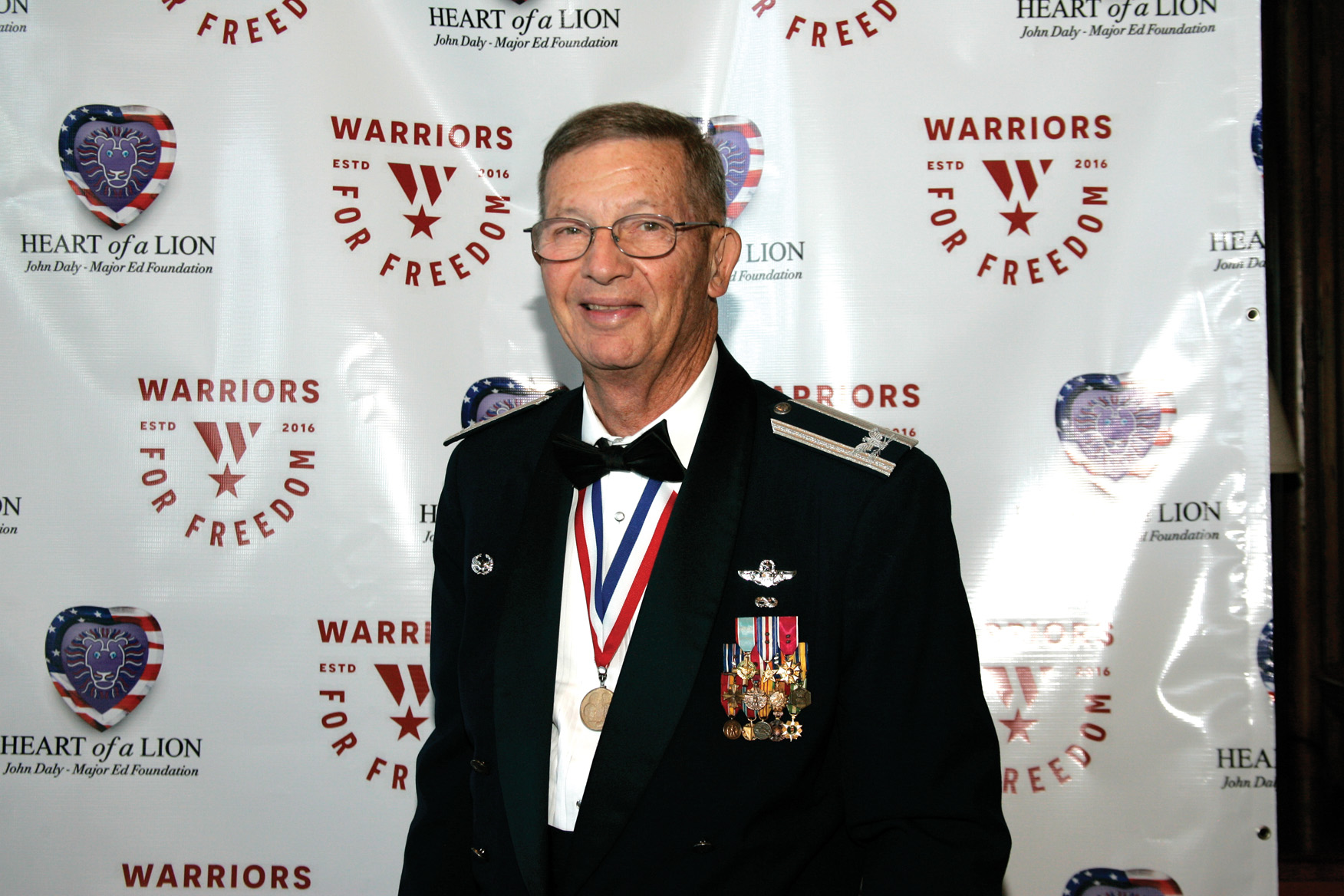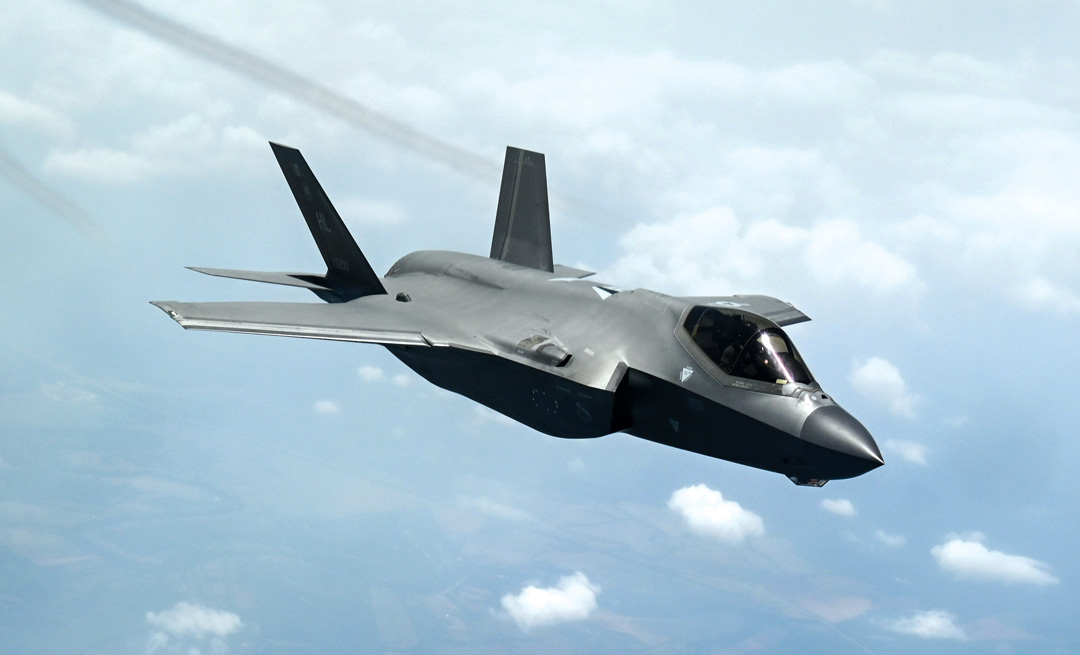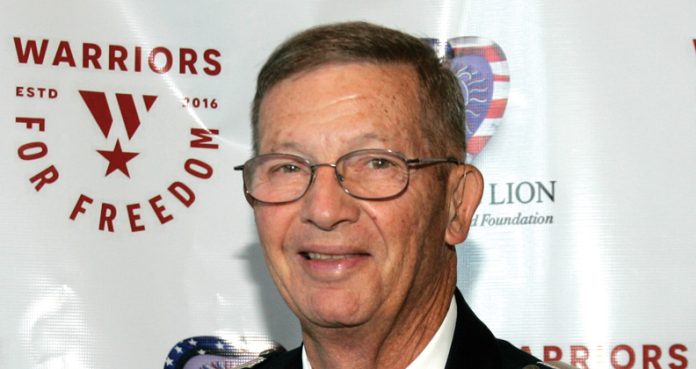Story and photos by Darl DeVault, contributing editor


Reminded of the importance of Tinker Air Force Base by the recent air show, America’s top air ace from the Vietnam War voiced some strong opinions about the significance of Tinker’s mission and how it is a linchpin for all the other aerospace concerns in Oklahoma.
Edmond’s U.S. Air Force Capt. Charles B. DeBellevue, now 77, became America’s first and only six MiG victory credit flying ace in 1972 in the skies of North Vietnam as an Air Force Weapon Systems Officer (WSO).
DeBellevue was an integral part of a two-person aircrew in the McDonnell Douglas F-4 Phantom II, a two-seat, twin-engine, all-weather, long-range supersonic jet interceptor and fighter bomber. His air-to-air missile victories earned him the Air Force Cross and three Silver Stars.
The now-retired colonel attended the recent Tinker AFB Air Show kicking off July with a patriotic glimpse at America’s air superiority on display, allowing the Air Force and Navy to command the sky over every battlefield for 70 years. Across its trailblazing 75-year history, the U.S. Air Force’s place as the world’s most capable and most respected source of airpower is well-established.
As the last ace to serve on active duty in the Air Force DeBellevue is proud that Oklahomans support Tinker’s mission. He says brave and hard-working men and women of our United States Air Force have provided 70 years of dominance in the skies above our ground troops worldwide.
A strong military has guaranteed the freedoms we enjoy,” DeBellevue said in an interview. “The civilian and military members of the USAF are an integral part of the team that ensures our freedom.”
Historians tell us April 15, 1953, was the last time an American ground troop was killed by ordnance delivered from an enemy aircraft.
“It is an honor to see Tinker servicemembers celebrate their role in this air dominance, and Oklahoma citizens flock to the base to salute the men and women who have served and now sacrifice daily to keep our proud country free,” DeBellevue said. “When I was in my F-4D Phantom II taking off from Udorn Royal Thai Air Force Base in Thailand, I was fearless because I knew I had the best support in the world, my fellow servicemen.”
Tinker AFB area residents have some understanding of the importance of DeBellevue’s role in becoming an ace. In today’s Air Force. The WSO duties are provided to the pilots of single-seat fighters by 32 crew members with 14 monitors on the Boeing E-3 Sentry, Airborne Warning and Control System commonly known as AWACS. The Air Force’s fleet of these planes providing all-weather surveillance, command, control, and communications are based at Tinker. They provide location and targeting data to today’s fighters.
The newest version of that high technology was on display at the air show July 1-2, when the world’s most advanced multi-role stealth fighter, the Lockheed Martin F-35A Lightning II competed with the US Navy’s Blue Angels for the crowds’ attention. A single fighter demonstrating its stealth and next-generation technology built to replace many older and less technologically advanced fighters performed each day.
The supersonic F-35A’s helmet-mounted display system is the most advanced system of its kind. All the intelligence and targeting information an F-35 pilot needs to complete a mission are displayed on the pilot’s helmet visor.
This latest version of the best America can build incorporates a robust version of the “AWACS” aircraft capability it can communicate to the theatre of operations it patrols. This enables it to aid all other aircraft in tracking and targeting the enemy and in flying the intercept needed to shoot them down. This new system is a radar, bombardier, navigational and weapons systems analyst. The pilot provides another set of eyes on the targets to give tactical input to all American forces, both flying and on the ground.
The US Navy was well represented at the air show, just as they are as a major tenant at Tinker. The Navy’s TACAMO unit sailors based at Tinker celebrated Navy Week at the base. TACAMO is the Navy E-6 Mercury aircraft, an airborne command post and communications relay based on the Boeing 707 aircraft, similar to the Air Force’s E-3 Sentry (AWACS).
Besides delighting the crowd for the air show with the precision flying of its Blue Angels demonstration team, Navy Week was present on the base and in Oklahoma City in the week leading up to the event.
The US Navy has had a strong presence at Tinker since 1990, with sailors of the TACAMO wing and their 62nd year of operations. While Tinker employs nearly 30,000 Oklahomans, a contingent of air mission Navy sailors numbering 1,500 are proud to be known as “Red Dirt Sailors.” There has been a long-standing Navy presence in the area attached to Strategic Communications Wing One (SCW-1) at Tinker. Other active-duty members are attached to the Navy Operational Support Center (NOSC) in Oklahoma City, the local recruiting district and numerous reserve personnel who live and work in the community.
The theme for the air show was STEM with a large area devoted to the many ways in which Science, Technology, Engineering and Math are used to advance aviation agendas. STEM has been ever-present in the area Air & Space Forces Association’s (AFA) chapter activities as it provides youth opportunities.
“The AFA’s mission is to promote a dominant U.S. Air and Space Force and a strong national defense through education, advocacy and support,” DeBellevue said. “It is an excellent way for community partners and interested individuals to become involved and learn about the Air Force and Tinker Air Force Base and have a say in patriotic issues.”
DeBellevue said the AFA Central Oklahoma Gerrity Chapter supports STEM education in Oklahoma and the Rosie the Riveter project. The group and Oklahoma Career Tech put on the CyberPatriot, StellaXplorer and STARBASE OKLAHOMA programs. These are middle and high-school-level programs to advance experiential STEM education.
Organizers boast about the programs by pointing out the national winner of the 2023 StellaXplorer Program was a team from Edmond North High School Air Force Junior ROTC.
Tinker AFB has long been the linchpin, along with the Mike Monroney Aeronautical Center, in attracting almost 300 businesses to Oklahoma to support America’s air dominance. The Oklahoma Defense Industry Association has partnered with the Air & Space Forces Association Gerrity Chapter 215 and Oklahoma Aeronautics Commission to support all those concerns over the years.
“Oklahomans’ exemplary work ethic and its central location make Tinker and Oklahoma an obvious location for supporting this country’s defense efforts,” DeBellevue said. “We see daily that Oklahomans and their state government here are very supportive of aviation and the aerospace industry.”
Oklahoma’s largest employer is the Department of Defense. Oklahoma’s aviation and aerospace industry produces $44 billion in annual economic activity, making it the second-largest economic engine in the state. Three segments account for the total: military aviation, $19.3 billion; off-airport aviation and aerospace businesses, $13.9 billion; and commercial and general aviation airports, $10.6 billion. The industry supports 206,000 jobs totaling an $11.7 billion payroll. The average salary in the industry is $73,300, making it one of the highest average salaries in the state.














